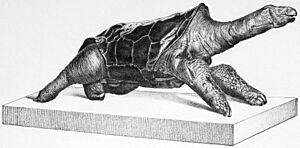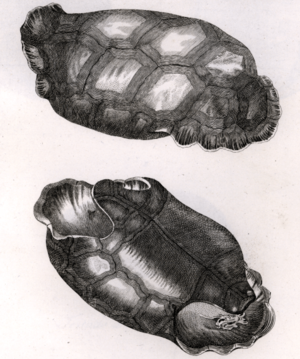Saddle-backed Rodrigues giant tortoise facts for kids
Quick facts for kids Saddle-backed Rodrigues giant tortoise |
|
|---|---|
 |
|
| Engraving of the only taxidermy specimen | |
| Conservation status | |
| Scientific classification | |
| Genus: |
Cylindraspis
|
| Species: |
vosmaeri
|
| Synonyms | |
|
|
- Testudo commersoni
Vaillant, 1898 - Testudo commersonii
Siebenrock, 1909
(ex errore) - Geochelone commersoni
— Pritchard, 1967 - Cylindraspis commersonii
— Wilms, 1999
| synonyms_ref = |status_ref= }}
The saddle-backed Rodrigues giant tortoise (Cylindraspis vosmaeri) was a huge tortoise that lived only on the island of Rodrigues. Sadly, this species is now extinct. It disappeared around the year 1800. Humans caused its extinction by hunting it too much.
Contents
What's in a Name?
The tortoise's scientific name, vosmaeri, honors a Dutch scientist named Arnout Vosmaer. He lived from 1720 to 1799.
Family Tree of the Rodrigues Tortoises
The saddle-backed Rodrigues giant tortoise and its smaller relative, the domed Rodrigues giant tortoise (Cylindraspis peltastes), both came from an older tortoise species. This ancestor lived on the island of Mauritius.
Millions of years ago, these ancestral tortoises traveled by sea to Rodrigues. Over time, they slowly changed and became the two different tortoise species found on Rodrigues.
How They Looked and Lived
The saddle-backed Rodrigues giant tortoise was a very tall species. It had a long, raised neck and a shell that curved upwards at the back. This made it look a bit like a sauropod dinosaur, with a giraffe-like body shape.
These tortoises ate leaves and branches from taller plants. Their smaller relatives, the domed Rodrigues giant tortoises, ate low-growing plants like fallen leaves and grasses.
Early settlers described the saddle-backed Rodrigues giant tortoise as calm and gentle. They often gathered in large groups, especially in the evenings. In 1707, a settler named Leguat wrote about their interesting group behavior:
"They always place guards a little way from the group. These guards turn their backs to the group and look around, as if they are watching. We always saw them do this. It's a mystery because these creatures cannot defend themselves."
Their Important Role in Nature
Giant tortoise herds played a vital part in the ecosystem of Rodrigues. They helped the island's forests grow back. For example, they spread tree seeds, helping new trees to sprout.
They also helped shape the island by keeping forest clearings open and creating pools of water. This process is sometimes called "terraforming" because they changed the land.
To help Rodrigues' environment recover, scientists have brought in other giant tortoises. These new tortoises are similar species from different parts of the world. The Aldabra giant tortoise (Aldabrachelys gigantea) from the Seychelles was chosen to replace the saddle-backed Rodrigues giant tortoise. It is similar in size, even though its body shape is different.
Why They Disappeared

When humans first arrived on Rodrigues, there were thousands of giant tortoises. Like many animals on isolated islands, they were friendly, curious, and not afraid of people.
However, humans began to hunt and export them for food. Also, new animals brought by humans, called invasive species, harmed the tortoises. These things quickly led to the tortoises' extinction.
In the 1700s, the French Governor Mahé de Labourdonnais tried to make laws to stop the "tortoise plundering." But the massive killing continued. Hundreds of thousands of tortoises were loaded onto ships for food. Others were taken to Mauritius to be burned for their fat and oil. Their shells were unusually thin, so many died from being crushed when they were packed tightly in ships.
In their final years, only smaller tortoises were found. They hid in isolated mountain areas inland. A surviving tortoise was reported in 1795, found at the bottom of a deep valley. As late as 1802, there were mentions of tortoises being killed in large fires. These fires were used to clear the island's plants for farming. However, it is not clear which of the two Rodrigues tortoise species these were, or which one survived the longest.



